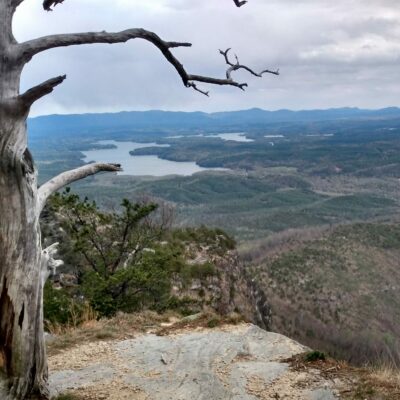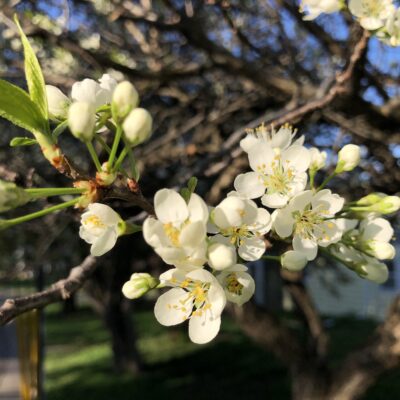Snags: The Life-Affirming Role of Dead Trees
Environmental educator Nick Voss ponders snags and life. (Photo: Nick Voss)
As winter becomes a not-so-distant memory, gardeners, greenhouses, and landscapers are thrilled to return to a celebration of life. But before we join the chorus, there’s the in-between gloomy zone of spring. Some may wait and suffer through it, but I invite you to join me in pausing to reflect on the role of gloom and death in the greater biosphere. One of the most common signs of death in the landscape are dead trees, also known as snags. While our manicured landscapes strive to keep snags out of sight, they’re actually much more useful and complex than we give them credit for.
Snags are used for nests, nurseries, storage areas, foraging, roosting, and perching. In the winter, hollow snags are valuable for squirrels, raccoons, owls, porcupines, and even bears. On a small scale, snags harbor insects such as beetles, spiders, and ants, essential food for woodpeckers, nuthatches, and other wildlife. Across time, they help regenerate soil. Though our first impression of snags may be of death, they actually sound quite lively!
Snags are much more than dead trees. For starters, they can be categorized as hard or soft. Hard snags are generally recently dead, with the bark intact and the inner heartwood and sapwood still firm. These are great features for cavity-nesting birds such as owls. Soft snags have been dead for a longer time or might be a tree of softer wood, such as cottonwood. Soft snags have more decay activity, with fungi infiltrating all the way to the center. Limbs are likely missing, and the top and much of the trunk are quick to fall. Once this happens, the decay and fungi spread into the soil to become a hotspot for insects, fungi, and even microbes such as protozoa and nematodes. From the time a tree dies to when it finally finishes decomposing, a snag can generate life even longer than when the tree was alive.
Many species take note of the textures of decaying wood and become specialists in a certain cavity size or tree type. Black-capped chickadees, for example, nest in snags as small as six-feet-tall, and sapsuckers seek out running sap, which indicates a soon-to-be snag when flowing out over the bark. Tree frogs, bats, and flying squirrels are just some of the wildlife that have their own preference for height, wood consistency, depth, and proximity to water.
Keeping snags on the landscape can of course be a challenge. Sometimes they present a hazard to people or property, especially in high-traffic areas. Keeping more snags standing will likely require a cultural reckoning. As reckonings often go, a convergence of viewpoints and aesthetic preferences can generate conflict, or an “us-versus-them” dynamic.
But what will we make of this conflict, and what tools do we have for a creative approach? One idea would be to try out new designs and cultivate a spectrum of dead spaces on the landscape. Parks, lakeshores, churchyards, or even golf courses likely have spaces that can serve as snag microhabitats. How much wood is left standing or on-site can vary. If just part of a snag is kept, it can offer jagged features, branches strategically left on the ground, or an intentional cavity that offers one more piece of microhabitat “real estate” in our growing turf-lawn deserts. Arborists can bring even more skills to the table to help in designing the snag’s role.
How can a healthy ecosystem complete with snags and decay fit into the life of humans? It’s no secret that the modern world chases youth, yet struggles to find harmony with death. When we try to erase death in nature and in our psyche, death reminds us that it’s indeed still there. The lessons of our ancestors are sure to come back to teach us, or maybe haunt us, if we don’t pause to integrate them with our present lives. Like snags, this isn’t a convenient process. But as we see in human and non-human worlds alike, a designated space for death among the living is essential.
As spring unfolds, the world’s current looming darkness makes it difficult to find harmony with death. In these times, I turn over a wet log in hopes to encounter a salamander. I pause to admire the rugged snag left out of reach of maintenance crews on the edge of the park. I think about the endings and beginnings in my own life, in the grander world, and for a moment ponder my own unavoidable death. In a way, the snag joins me, joins us, in this reflection. From the darkness, it is a gift, a focus point and an anchor, to remind us of what’s real. In gratitude, I return to the hum of the living with a renewed sense of hope and wonder.
— Nick Voss, Education & Outreach Coordinator, Vadnais Lake Area Water Management Organization.


